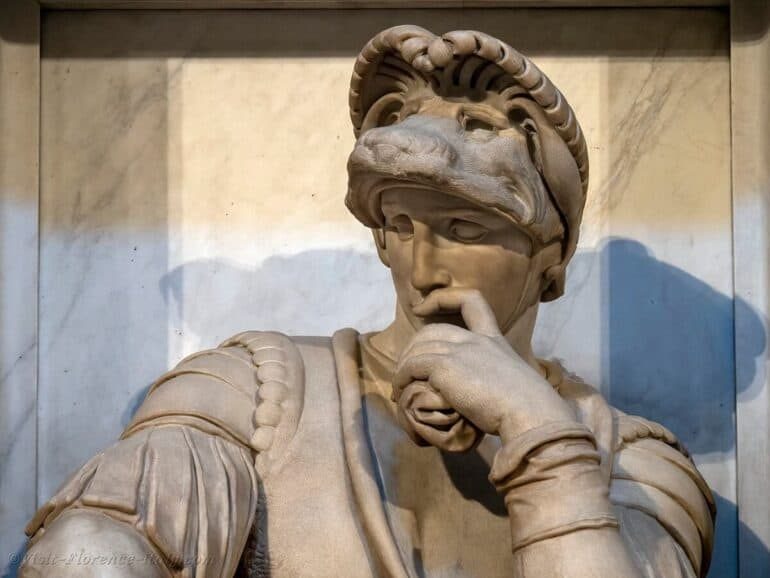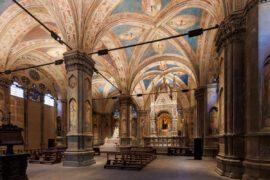Where to see Michelangelo’s Masterpieces in Florence
This Tuscan native has influenced the world of art one masterpiece at a time. Michelangelo’s artistic visions have carved the most remarkable artworks here in the city of Florence. Discover the many paintings, sculptures, and architecture that have been crafted by one of the greatest artists of all time.
Born in 1475, Michelangelo di Lodovico Buonarroti Simoni, better known as Michelangelo, was a painter, sculptor, and architect. Michelangelo was born into a middle-class family of bankers in a small village called Caprese in Tuscany. After losing his mother at six years old he was put into primary care with his nanny, who was married to a stonecutter. The lack of artistic ability in his biological family makes some believe his love for sculpting marble was the result of his upbringing in the hands of the stonecutter. By the age of 13 he became an apprentice under Domenico Ghirlandaio, where he learnt various painting techniques including frescoes. He then went on to study the work of great masters of sculpting: Giotto, Masaccio, Donatello, and other Greek and Roman sculptors. Michelangelo finally died in Rome when he was 88 years old in 1564, but over 400 years later his legacy remains.
Michelangelo is one of the greatest because of his artistic vision and his profound confidence in his work. Unlike other sculptors, Michelangelo never needed a clay model before tackling a giant block of marble. He had the ability to see through the marble and the statue that existed within. Below we’ll discover his masterpieces located in Florence.
I saw the angel in the marble and carved it until I set him free.
Michelangelo
- Madonna Della Scala
- Battle of the Centaurs
- Crucifix at Santo Spirito Church
- Bacchus
- Tondo Pitti
- David-Apollo
- Brutus
- David
- Non-Finito Collection
- The Awakening Slave
- The Young Slave
- The Bearded Slave
- The Atlas
- Doni Tondo, The Holy Family
- The Genius of Victory
- Pietà Bandini
- New Sacristy of San Lorenzo Basilica
- Laurentian Library
Madonna Della Scala
Casa Buonarroti, Via Ghibellina 70
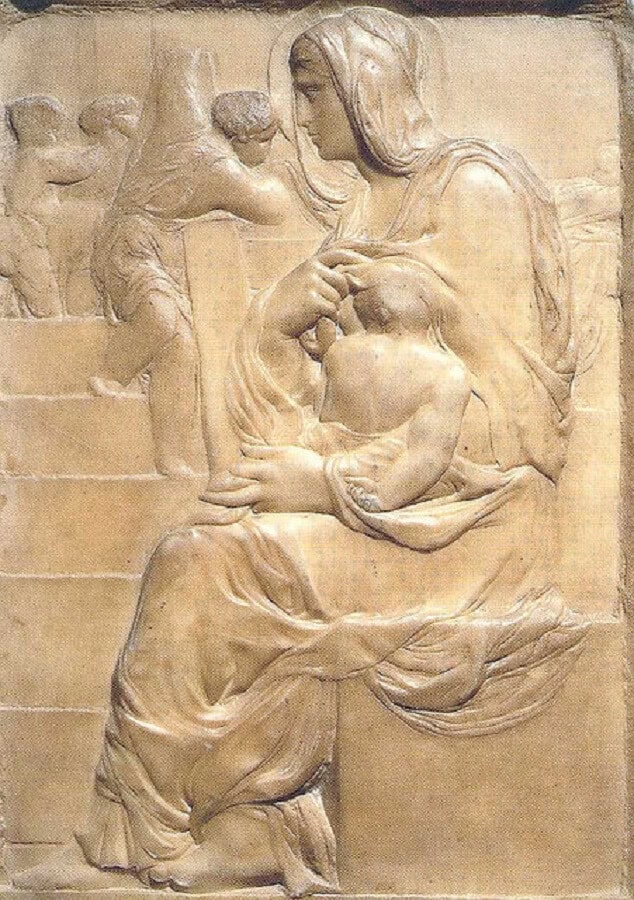
Madonna Della Scala (1490), also known as Madonna of the Staircase, is Michelangelo’s first known sculpture (it is believed that he completed this piece when he was only 15 years old!). The sculpture reflects a technique influenced by Donatello called “stiacciato.” This style allows the artist to create a relief sculpture that creates the illusion of depth, when in reality it is only millimeters of carving. Madonna Della Scala resides at the Casa Buonarroti Museum.
Battle of the Centaurs
Casa Buonarroti, Via Ghibellina 70

The marble sculpture depicts the Greek mythical battle of Lapiths and the Centaurs, which Michelangelo completed at 17 years old. This sculpture breaks away from the traditional styles of his masters and introduces Michelangelo’s unique approach. This was the first observation of his “non-finito,” or “unfinished” style, which is demonstrated by the chisel marks above the image. Whether the unfinished look was intentional or not, The Battle of the Centaurs (1492) is one of his best early works and can be found in the Casa Buonarroti.
Crucifix at Santo Spirito Church
Santo Spirito Church, Piazza di Santo Spirito 30
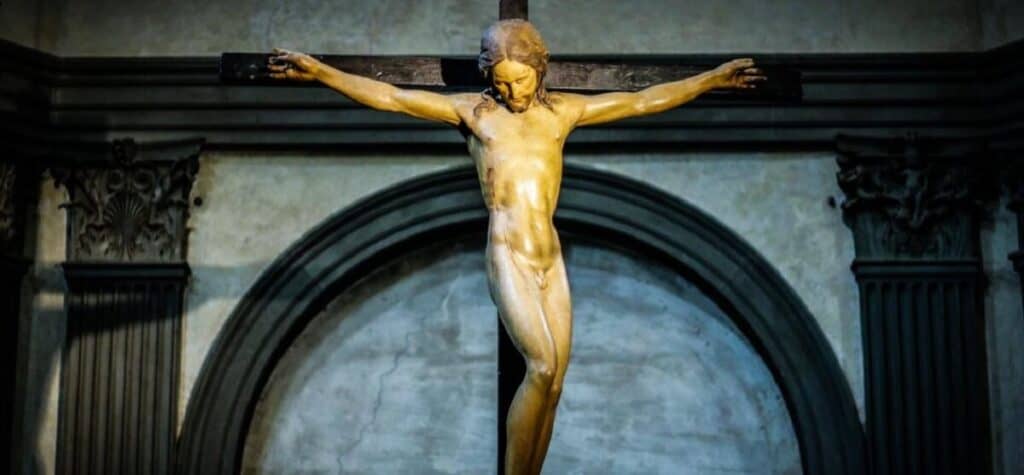
As a dedicated artist, Michelangelo was determined to make his craft perfect. He practiced dissecting corpses to understand human anatomy so that he could sculpt it to perfection. In return for the wooden Crucifix (1492) at Santo Spirito Church, Michelangelo was given space to study human anatomy in secret, as this practice was prohibited. This masterpiece was lost for decades, but in 1962 it was found and restored. It is still at the Church of Santo Spirito.
Bacchus
Bargello National Museum, Via del Proconsolo 4
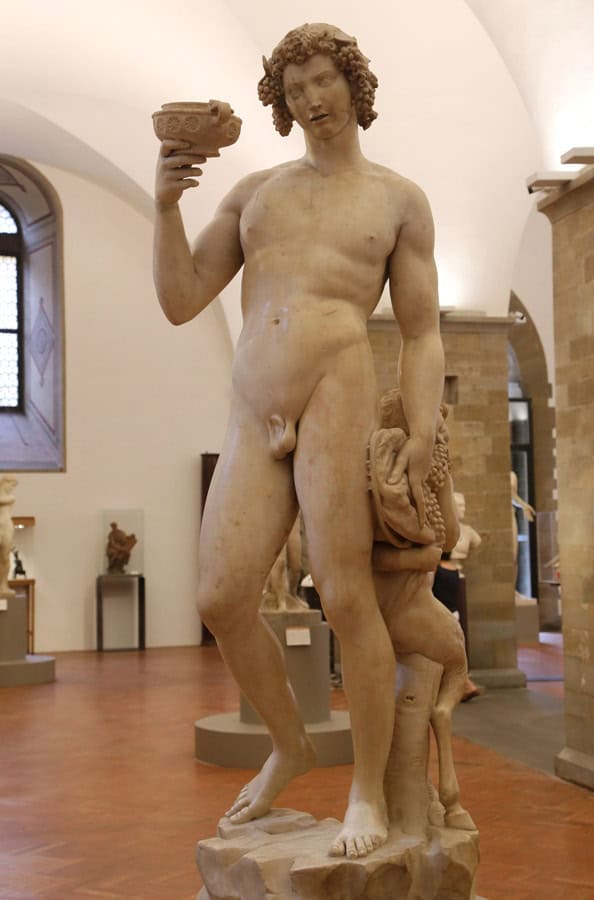
Michelangelo’s first standing large statue portrays the Roman god of wine attempting to balance while intoxicated. In one hand, the statue holds a wine glass and in the other a lion’s skin symbolizing death from the legend of Hercules. A small statue of a goddess stands next to the Roman god. Bacchus (1496-97) is an early example of Michelangelo’s brilliance in his ability to accurately sculpt the human body, with a clear difference between man and woman. This artwork can be found in the Bargello National Museum.
CLICK HERE TO BUY BARGELLO MUSEUM TICKET
Tondo Pitti
Bargello National Museum, Via del Proconsolo 4
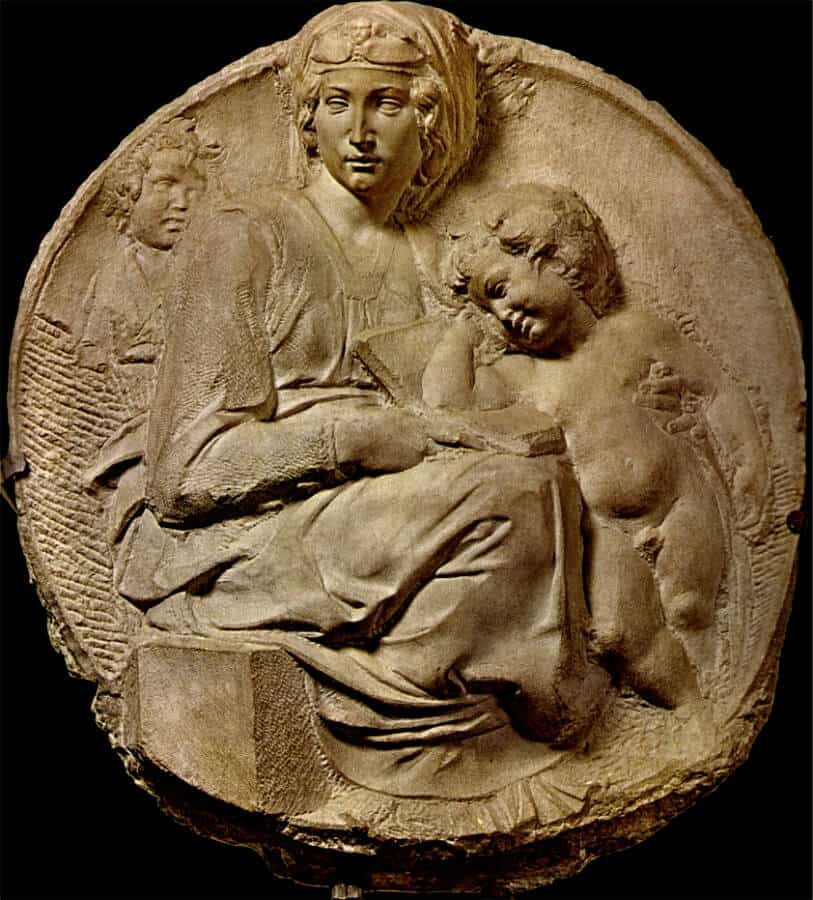
The Tondo Pitti (1503-05), commissioned by Bartolomeo Pitti, depicts the Virgin Mary, baby Jesus, and San Giovanni. This sculpture, influenced by Leonardo Da Vinci’s style, also reflects Michelangelo’s “non-finito” style. A very interesting element to note is what appears to be an angel on the Virgin Mary’s forehead to signify the prophecies. The Pitti Tondo was first exhibited in the Uffizi Gallery and now can be found in the Bargello National Museum.
David-Apollo
Bargello National Museum, Via del Proconsolo 4
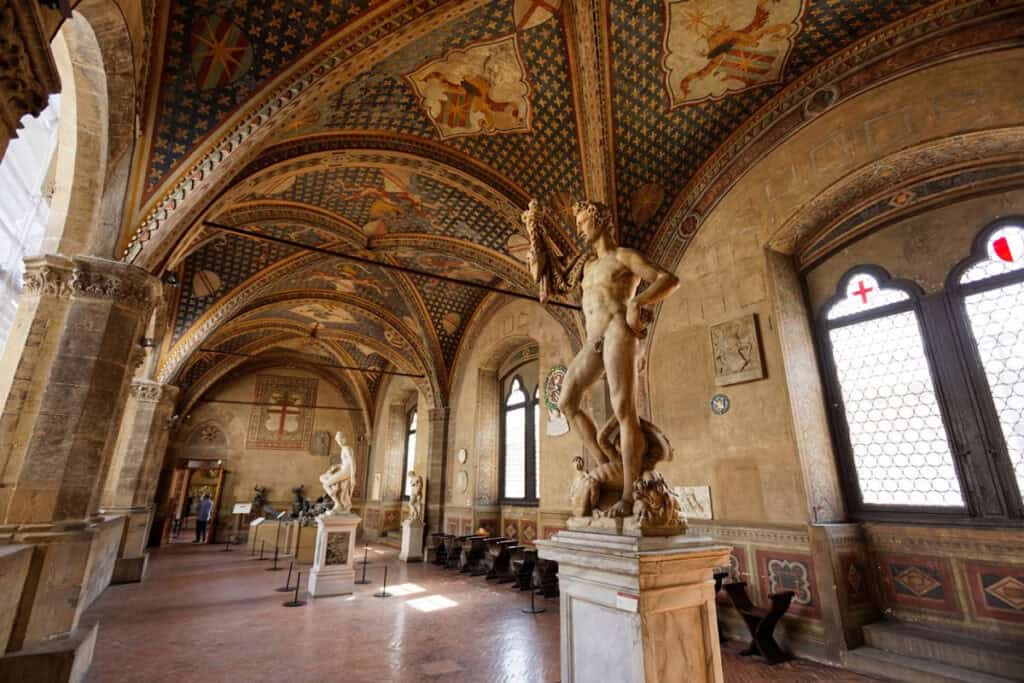
The unfinished marble statue depicting a nude man has scholars questioning whether Michelangelo intended sculpting David or Apollo. Beneath his right foot sits a block of marble which some speculate would be the head of Goliath. Nonetheless, the complexity and definition of the sculpture is nothing short of remarkable. The David-Apollo (1530) is located at the Bargello National Museum.
Brutus
Bargello National Museum, Via del Proconsolo 4
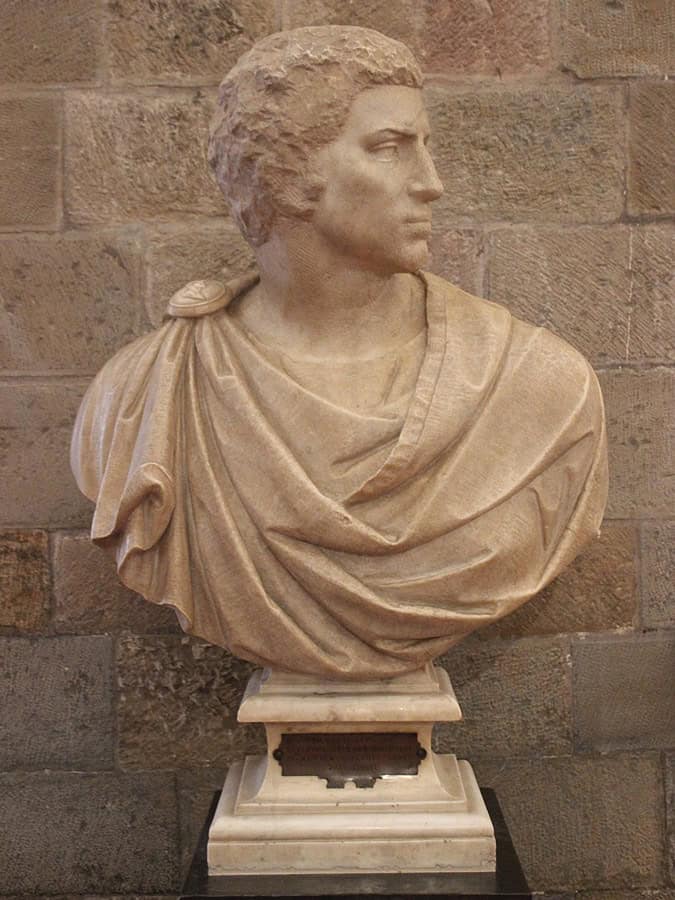
When they say the face says it all, that is exactly what Michelangelo intended with Brutus (1538). Brutus was Michelangelo’s way of making a political statement towards the Medici Family, the ruling family at the time. The marble statue is a representation of a Roman Statesman who planned Julius Caesar’s downfall. The sculpture embodies strength and freedom from the way the head is turned and if you look closely, Brutus’ face expresses a whirlwind of emotions including rage and hatred. Brutus resides in the Bargello National Museum and showcase’s Michelangelo’s ability to fine detail.
David
Accademia, Via Ricasoli 58/60
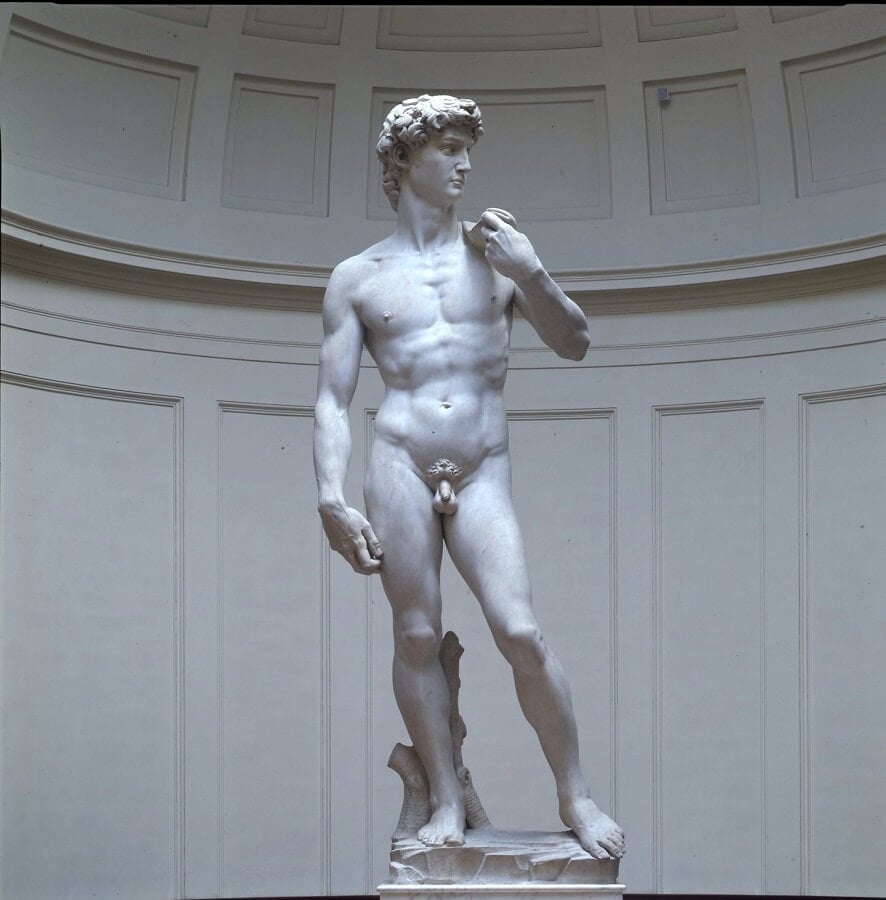
The infamous David (1501-04) is a masterpiece of the Early Renaissance. The 17-foot-tall sculpture depicting the prophet David was originally commissioned to be placed at the foot of the Dome at the Cathedral of Santa Maria del Fiore. This work of art is a true testament to Michelangelo’s genius. The marble was left untouched for 40 years due to the abandonment of previous sculptors who believed the marble contained too many imperfections. Michelangelo sculpted David as he waits for the right moment to fight Goliath with the help of God’s will. This breathtaking masterpiece was initially located outside of the Palazzo Vecchio, but to preserve the artwork it was moved to the Accademia in 1883. A perfect replica sits outside of the Uffizi, but the original is a worthwhile sight.
Non-Finito Collection
Accademia, Via Ricasoli 58/60
In 1505, Michelangelo was commissioned to create 40 sculptures for the tomb of Pope Julius II Della Rovere. The four sculptures of prisoners/slaves were initially intended for the lower part of the tomb, however after a year, due to the lack of funds Michelangelo was forced to put off this grand project. After Michelangelo’s death these four sculptures were found in his studio and now are displayed in the Academia just steps away from the David. The most valuable takeaway from these four sculptures is understanding Michelangelo’s technique. Michelangelo believed the statues already existed in the blocks of marble placed there by God and it was simply his job to find them. Whether Michelangelo didn’t finish the statues or they were meant to be the way they are, each figure tells its own story.
The Awakening Slave
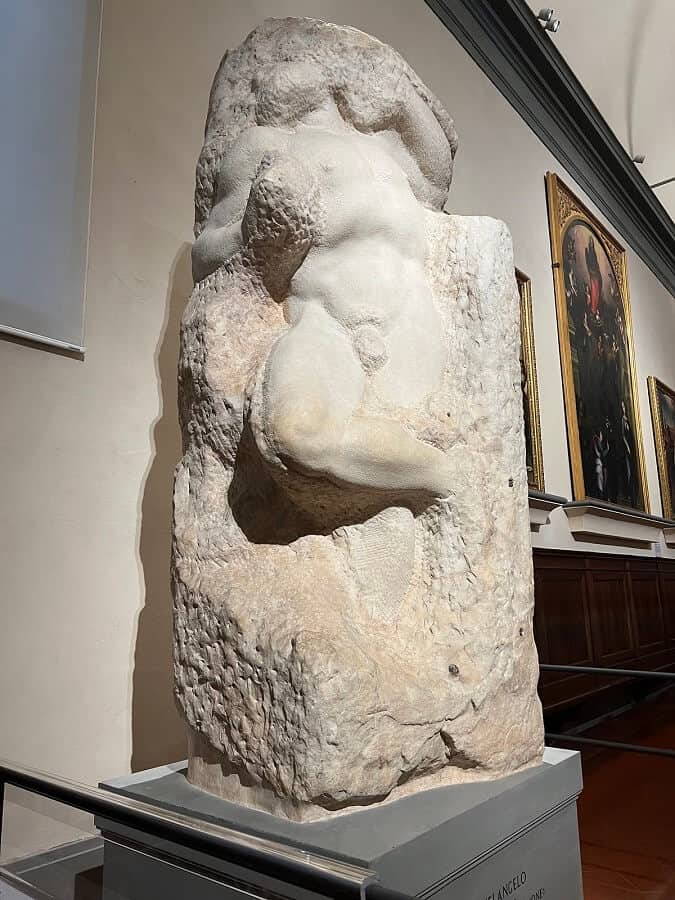
The Awakening Slave (1520-23) will be the first statue on the left corridor when entering the Academia. Art is always open to interpretation from the viewer, but here it seems that Michelangelo is illustrating mankind’s struggle to break free. Whether it is internal or external strengths, we may never know. The most interesting aspect of this sculpture is the completely unfinished backside.
The Young Slave

Across from the Awakening Slave, sits the Young Slave (1530-34). This youthful looking statue is confined to the marble beneath him. The Young Slave accentuates Michelangelo’s understanding of human anatomy with intricate detail.
The Bearded Slave
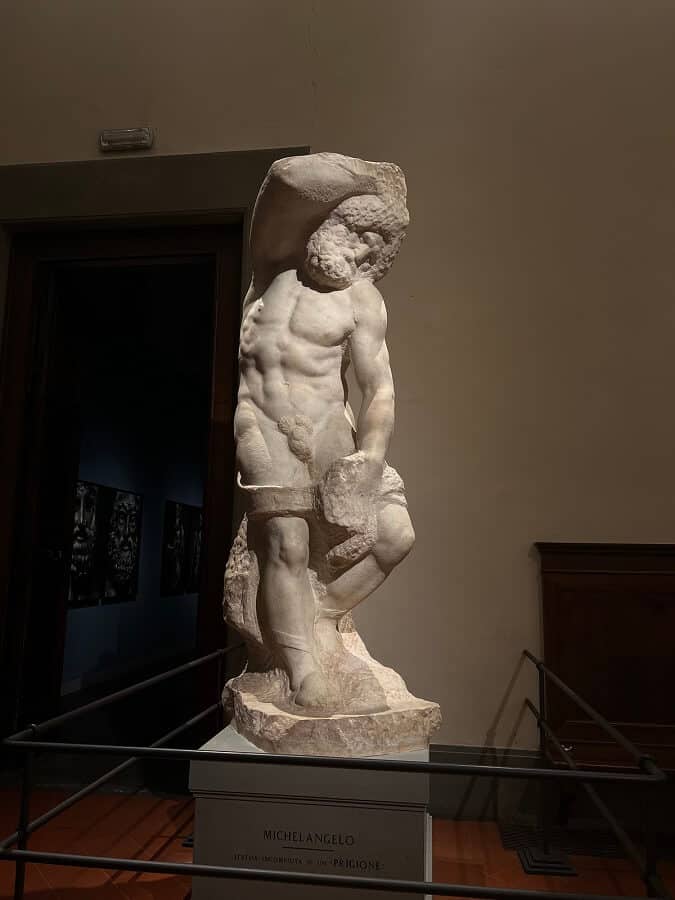
The third statue on the left side of the hall is The Bearded Slave (1530-34). This piece is the most complete from the collection. It features a thick, defined beard, a muscular body, covered by a cloth wrapped around his legs.
The Atlas
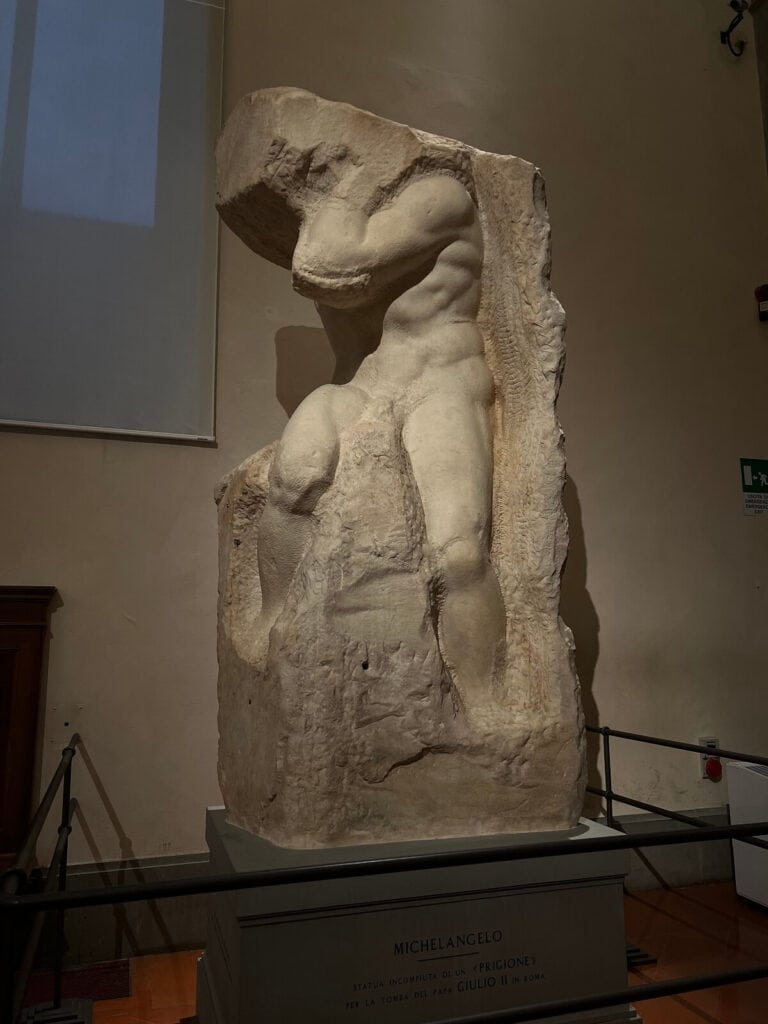
Last, but certainly not least is The Atlas (1530-34). The male figure is holding a block of marble above his head. According to Greek mythology, Atlas was a Titan who carried the world on his shoulders. The Atlas embodies the idea of the statue struggling to break free from the marble.
Doni Tondo, The Holy Family
Uffizi Gallery, Piazzale degli Uffizi 6
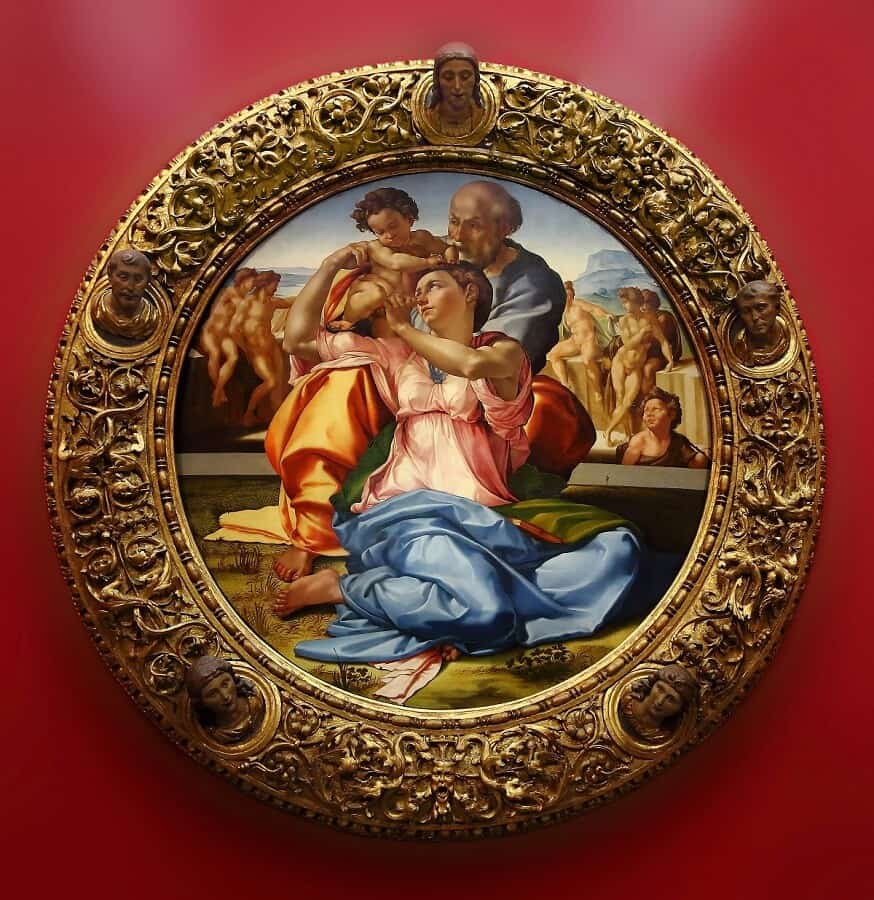
Although painting wasn’t Michelangelo’s greatest passion, his stroke with a paintbrush was still undeniably one of a kind. The Holy Family (1505-06), also known as the Doni Tondo, is Michelangelo’s only finished panel painting. The Holy Family is incredibly vibrant, and its figures are so clearly defined that they look carved into the portrait. The Holy Family was commissioned for the marriage of Angelo Doni and Maddalena Strozzi and can be found in the Uffizi Gallery.
The Genius of Victory
Palazzo Vecchio, P.za della Signoria
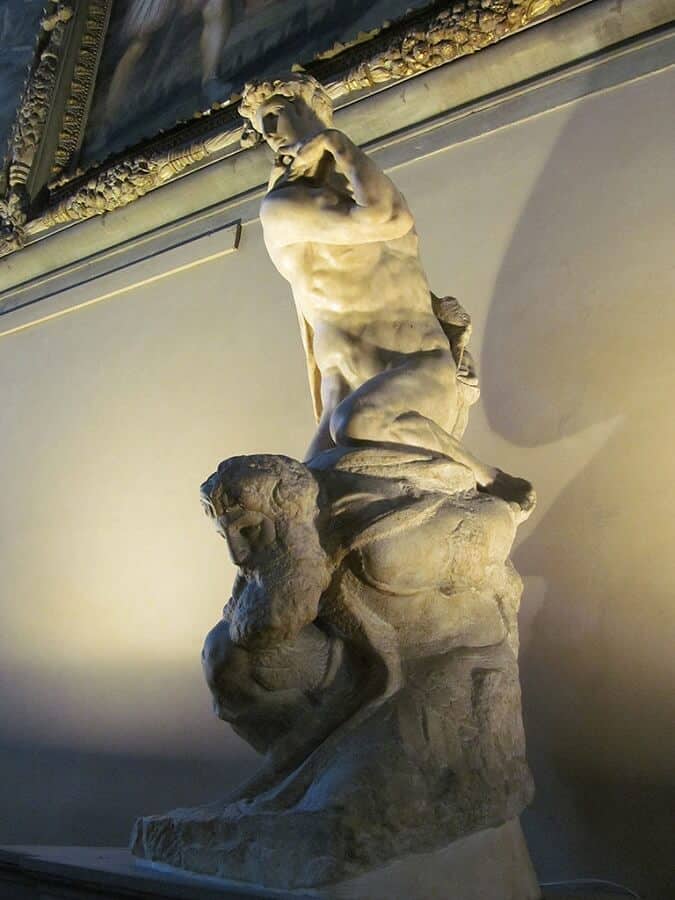
This marble statue showcases a young man standing tall with one foot resting on his opponent’s head to illustrate the contrast between power and defeat. The statue’s muscular body and strong stance symbolizes the figure’s great power. The Genius of Victory (1532-34) was originally commissioned for the collection of Pope Julius II tomb and resides today in the Palazzo Vecchio.
Pietà Bandini
Museo dell‘Opera del Duomo, Via della Canonica 1
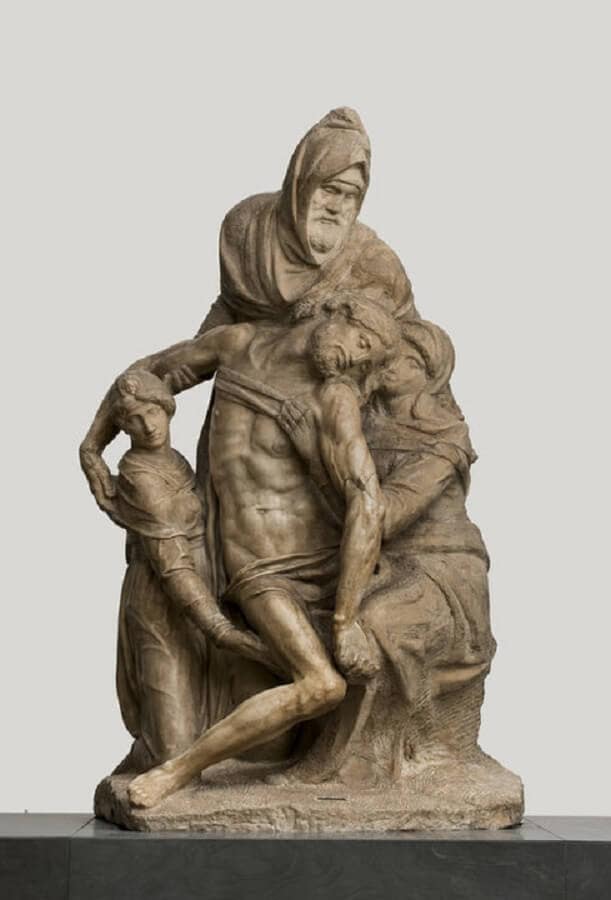
Michelangelo had a fascination for the Pieta, which depicts the moment in which the Virgin Mary holds Jesus Christ’s lifeless body after his removal from the cross. The Pietà Bandini (1547-55) was one of Michelangelo’s final pieces before his death and he intended it to be a monument for his own burial. Before the sculpture’s final completion Michelangelo was unhappy with the result, in an act of frustration he banged the sculpture with a hammer. It was later restored and is now located at the Museo dell‘Opera del Duomo.
New Sacristy of San Lorenzo Basilica
San Lorenzo Basilica, Piazza di San Lorenzo 9
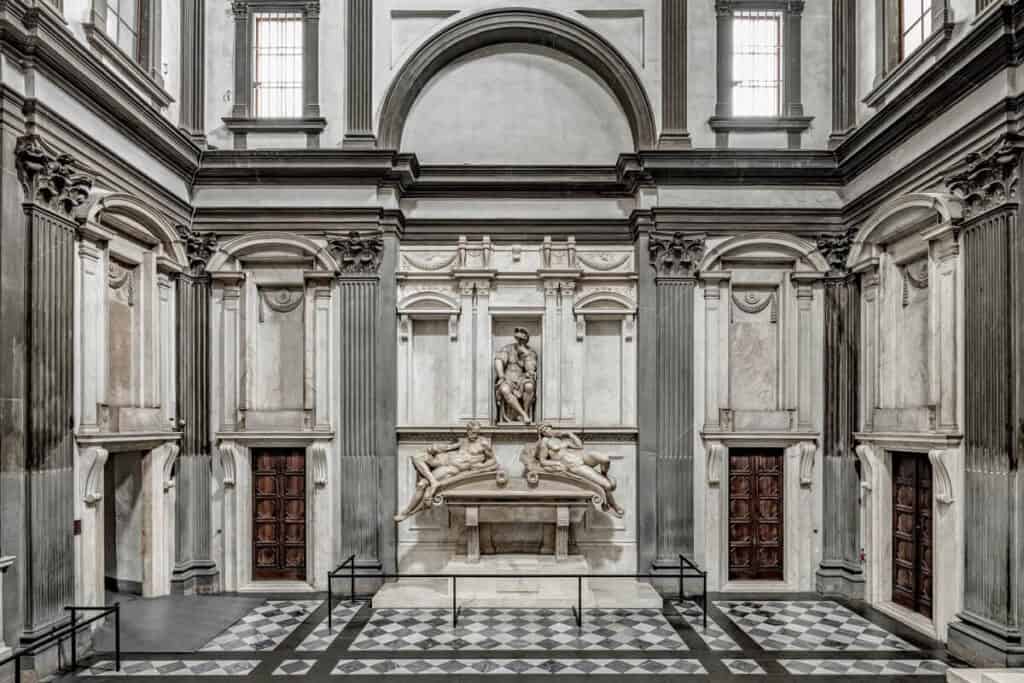
As a man of many talents, Michelangelo was commissioned to design and decorate a New Sacristy and mausoleum for the Medici Family. The New Sacristy (1520-34) is located opposite the Old Sacristy, designed by Brunelleschi in 1428, in the San Lorenzo Church. The New Sacristy resembles the style of the Old Sacristy including a dome and decorative panels.
Laurentian Library
Laurentian Library, Piazza San Lorenzo 9
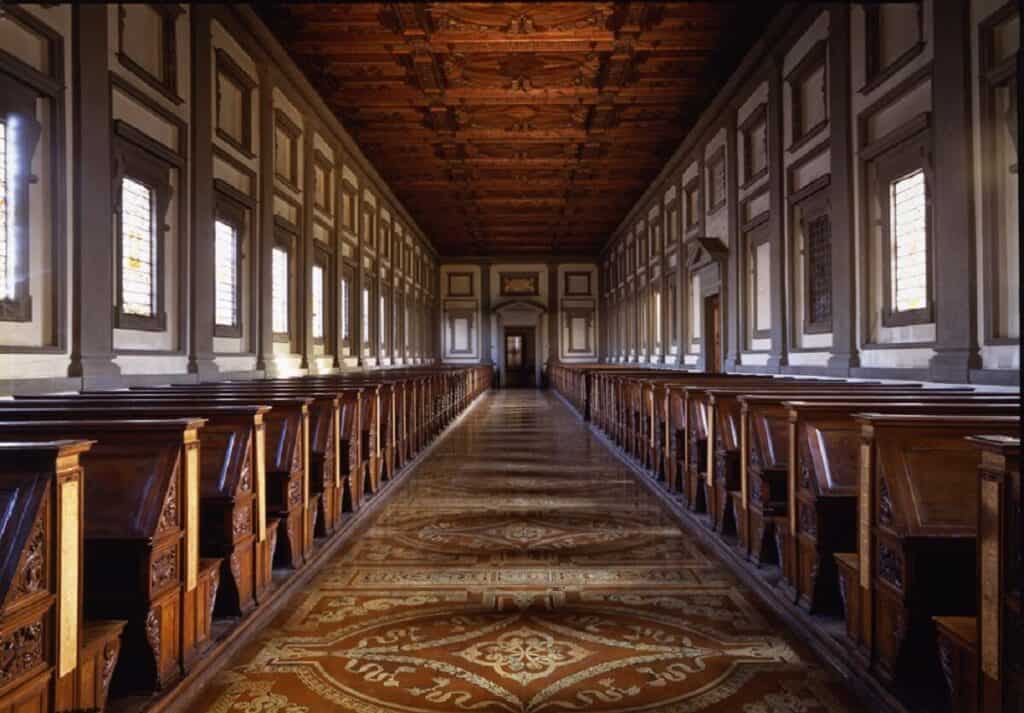
In addition to the New Sacristy, Michelangelo also designed the Laurentian Library (1525) for the Basilica of San Lorenzo. The library represents one of Michelangelo’s greatest architectural achievements with an innovative use of space and it houses some of the most valuable manuscripts in the world. The Laurentian Library showcases a Mannerism style of architecture developed by Michelangelo, which goes against a traditional, harmonious look. Today the Laurentian Library is an historical museum.


